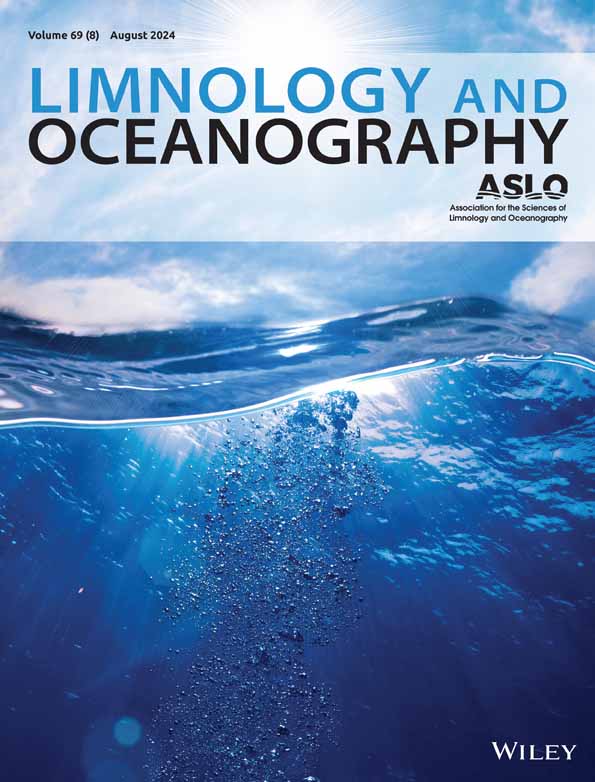Can intense storms affect sinking particle dynamics after the North Atlantic spring bloom?
IF 3.8
1区 地球科学
Q1 LIMNOLOGY
引用次数: 0
Abstract
The sinking of large particles (i.e., marine snow) has long been recognized as a key pathway for efficient particulate organic carbon (POC) export to the ocean interior during the decline of spring diatom blooms. Recent work has suggested that particles smaller than marine snow can also substantially contribute to POC export. However, a detailed characterization of small and large sinking particles at the end of blooms is missing. Here, we separately collected suspended and small and large sinking particles using Marine Snow Catchers and assessed their biogeochemical composition after the North Atlantic spring bloom in May 2021. During the 3 weeks of sampling, when four intense storms (maximum wind speeds 37–50 kt) created high turbulent kinetic energy dissipation rates and deepened the mixed layer, we observed two distinct sedimentation events. At first, sinking particles were dominated by small (diameter < 0.1 mm), slowly sinking ( 18 m d强烈风暴能否影响北大西洋春花盛开后的下沉颗粒动力学?
长期以来,人们一直认为大颗粒物(即海洋雪)的下沉是春季硅藻大量繁殖衰退期间向海洋内部有效输出颗粒有机碳(POC)的关键途径。最近的研究表明,比海洋雪更小的颗粒也能为 POC 的输出做出重大贡献。然而,目前还没有关于藻华结束时大小沉降颗粒的详细描述。在此,我们使用海洋捕雪器分别收集了悬浮颗粒和大小沉降颗粒,并评估了它们在 2021 年 5 月北大西洋春季水华后的生物地球化学组成。在取样的 3 周内,四次强风暴(最大风速 37-50 kt)造成了很高的湍流动能耗散率并加深了混合层,我们观察到了两种截然不同的沉积事件。起初,下沉的颗粒主要是富含二氧化硅的小颗粒(直径为 0.1 毫米),下沉速度较慢(18 米/天),这些颗粒携带适度的 POC 通量(6 毫摩尔碳/米-2/天)到达 500 米深处。风暴停止后,体积大(直径 0.1 毫米)、下沉速度快(75 米/天)、富含碳的海雪聚集体(非粪便颗粒)成倍增加,100 米深处的 POC 通量(30 ± 12 毫摩尔碳米-2/天)是前一次风暴期间的四倍多。聚集体由开花后的混合浮游生物群落组成。我们的数据表明,风暴影响了春季浮游植物绽放结束时 POC 通量的时间、类型和大小。
本文章由计算机程序翻译,如有差异,请以英文原文为准。
求助全文
约1分钟内获得全文
求助全文
来源期刊

Limnology and Oceanography
地学-海洋学
CiteScore
8.80
自引率
6.70%
发文量
254
审稿时长
3 months
期刊介绍:
Limnology and Oceanography (L&O; print ISSN 0024-3590, online ISSN 1939-5590) publishes original articles, including scholarly reviews, about all aspects of limnology and oceanography. The journal''s unifying theme is the understanding of aquatic systems. Submissions are judged on the originality of their data, interpretations, and ideas, and on the degree to which they can be generalized beyond the particular aquatic system examined. Laboratory and modeling studies must demonstrate relevance to field environments; typically this means that they are bolstered by substantial "real-world" data. Few purely theoretical or purely empirical papers are accepted for review.
 求助内容:
求助内容: 应助结果提醒方式:
应助结果提醒方式:


